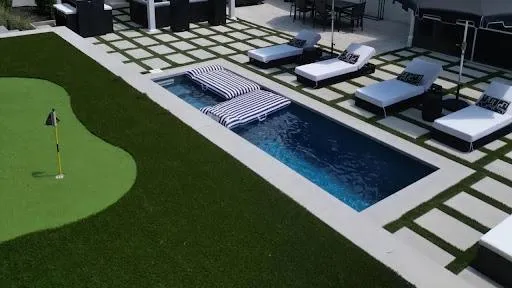Blogs

Benefits Of Artificial Turf?
Artificial turf offers low maintenance, water conservation, durability, safety for children and pets, year-round aesthetic appeal, environmental benefits, cost-effectiveness, versatility, no mud, and consistent color—making it a popular landscaping choice.
Unlike natural grass, artificial turf requires minimal upkeep, provides a consistently vibrant appearance, and remains resilient through various weather conditions. This solution aligns perfectly with modern lifestyles, where people seek beautiful, practical, and low-maintenance outdoor spaces.
At Greystone Hardscapes, we’re committed to helping you create the ideal outdoor environment. Serving Matthews, Charlotte, Weddington, Indian Trail, Waxhaw, Wesley Chapel, and beyond, we offer high-quality artificial turf installations as part of our comprehensive landscaping and hardscaping services.
Key Takeaways
Low-maintenance landscaping with no mowing or fertilizing needed.
Significant water savings and cost-effective in the long term.
Durable and safe for high-traffic areas, children, and pets.
Environmentally friendly, requiring fewer chemical applications.
Year-round lush appearance and color consistency.
Key Benefits Of Artificial Turf
Low Maintenance Artificial turf is the perfect solution for busy homeowners. No mowing, weeding, or fertilizing is required, saving you time, effort, and money. A quick rinse with a hose and an occasional brush keep it looking great, making it an ideal option for those who want a beautiful lawn without the hassle.
Water Conservation Artificial turf is water-efficient, requiring no irrigation compared to the gallons of water natural lawns consume annually. This aspect is especially beneficial in drought-prone areas and can result in significant savings on water bills. A simple rinse to remove dust and debris occasionally is all that’s needed.
Durability and Longevity Built to withstand heavy use, artificial turf is ideal for families, pets, and active outdoor spaces. Its resilience means it doesn’t wear down or develop bald spots like natural grass. A quality installation can last 10-25 years, offering excellent value over time.
Safety for Children and Pets Artificial turf is often crafted from non-toxic materials, making it safe for children and pets. With no need for harmful pesticides or fertilizers, artificial turf minimizes the risk of chemical exposure, providing a safer environment for all.
Aesthetic Appeal Artificial turf remains vibrant and lush year-round, regardless of the season or weather conditions. It avoids the browning, patchiness, and other issues natural grass experiences, ensuring a consistently beautiful lawn in all seasons.
Environmental Benefits With artificial turf, you reduce your reliance on chemical fertilizers and pesticides, which can be harmful to local ecosystems. Many turf options are made from recycled materials and can be recycled themselves, making this a sustainable choice for environmentally conscious homeowners.
Cost-Effectiveness Though the initial cost of artificial turf may be higher, the reduction in water usage, lawn care services, and equipment purchases adds up over time. Many find that artificial turf pays for itself, especially given its long lifespan.
Versatility Artificial turf adapts well to various settings, from residential lawns to sports fields, and even in indoor applications. Its flexibility in design and adaptability to diverse environmental conditions make it a versatile choice for any project.
No Mud or Mess Unlike natural grass, artificial turf does not create mud or mess after rainfall, making it ideal for households with pets and children. This feature helps keep indoor spaces cleaner and reduces the need for frequent floor cleaning.
Consistent Color and Texture High-quality artificial turf is UV-stabilized to prevent fading, keeping it vibrant and green throughout its lifespan. This consistency in color and texture is a major advantage over natural grass, which can lose its luster over time.
Artificial Turf Maintenance: Tips for Longevity
Artificial turf is low-maintenance, but adopting a few essential care practices can help maximize its lifespan and appearance. Routine cleaning, brushing, and careful attention to high-use areas will keep your lawn looking great for years to come.
Regular Cleaning: Rinse periodically to remove dirt and dust.
Brushing: Brush fibers gently to keep them upright.
Prevent Damage: Avoid placing heavy items that could compress fibers.
Spot Treating Stains: Use mild soap and water for spills.
Seasonal Care: Clean leaves and debris in fall and winter.
Comparing Natural Grass and Artificial Turf: Which is Right for You?
Choosing between natural grass and artificial turf depends on your priorities, from maintenance needs to environmental impact. We’ll outline key factors to consider to help you determine the best choice for your outdoor space.
Maintenance: Turf requires less mowing and upkeep.
Cost: Initial installation costs for turf are higher but save long-term.
Environmental Impact: Artificial turf saves water, while grass supports local ecosystems.
Appearance: Turf stays green year-round, while grass varies seasonally.
Durability: Turf is more resilient for high-traffic areas.
Artificial Turf for Pet Owners: Benefits and Considerations
Artificial turf is a practical solution for pet owners, offering a clean, durable, and pet-safe surface. Explore the specific benefits and considerations, including best practices for cleaning and managing pet waste on artificial lawns.
Durability: Resists damage from claws and play.
Easy Cleaning: Rinses clean quickly, ideal for pet waste.
Odor Control: Choose turf with antimicrobial properties.
Safety: No pesticides or chemicals needed, safe for pets.
Comfort: Turf is softer and stays cooler for pets.
How to Choose the Right Artificial Turf for Your Space
Selecting the right artificial turf involves assessing your landscape needs and preferences. This guide covers key factors to consider, from material type to density, so you can find the perfect turf for your space.
Turf Material: Choose from nylon, polyethylene, or polypropylene.
Pile Height: Select shorter for heavy use; longer for aesthetics.
Density: Higher density looks fuller and feels softer.
Infill Options: Sand or rubber infill for comfort and stability.
Drainage: Ensure efficient drainage to prevent water pooling.
Eco-Friendly Landscaping Options: Artificial Turf and Beyond
For eco-conscious homeowners, artificial turf is just one of many sustainable landscaping options. Learn about additional green alternatives like drought-tolerant plants and efficient irrigation to create a beautiful, earth-friendly yard.
Drought-Tolerant Plants: Reduce water use with native plants.
Permeable Pavers: Allow water to naturally drain and prevent runoff.
Efficient Irrigation: Install drip systems to conserve water.
Rain Gardens: Capture rainwater for natural irrigation.
Composting: Enrich soil while reducing waste.
Frequently Asked Questions About Artificial Turf
Can you put artificial turf directly on dirt?
Yes, but it’s best to prepare the area first by removing grass and debris, leveling, and compacting the soil to ensure a smooth, stable surface for the turf.
How long before you can walk on artificial grass?
Typically, you can walk on artificial grass immediately after installation. However, waiting 24 hours allows the infill to settle for optimal stability.
How to put artificial grass down on concrete?
Clean and level the concrete, then add a shock-absorbing underlay if desired. Lay the turf, secure it with adhesive, and trim the edges for a seamless look.
How do I prepare my area for artificial grass?
Clear any grass and debris, level the ground, and compact it. Add a layer of crushed stone for drainage, then compact again for a solid base.
Does artificial turf let water through?
Yes, artificial turf has a perforated backing that allows water to drain through, preventing puddling and promoting efficient drainage.
Contact Us for Artificial Turf Services in Charlotte NC Today!
Transform your landscape with our premium artificial turf. Contact us now for a free quote and let Greystone Hardscapes bring your outdoor vision to life with expert craftsmanship!
You Dream It.
We Build It.
Superior Craftmanship.
Every Time.
Hardscape Services:
Copyright © Greystone Hardscapes Inc. 2025. All Rights Reserved. Privacy Policy. Terms & Conditions. Web Design by Fused Media


